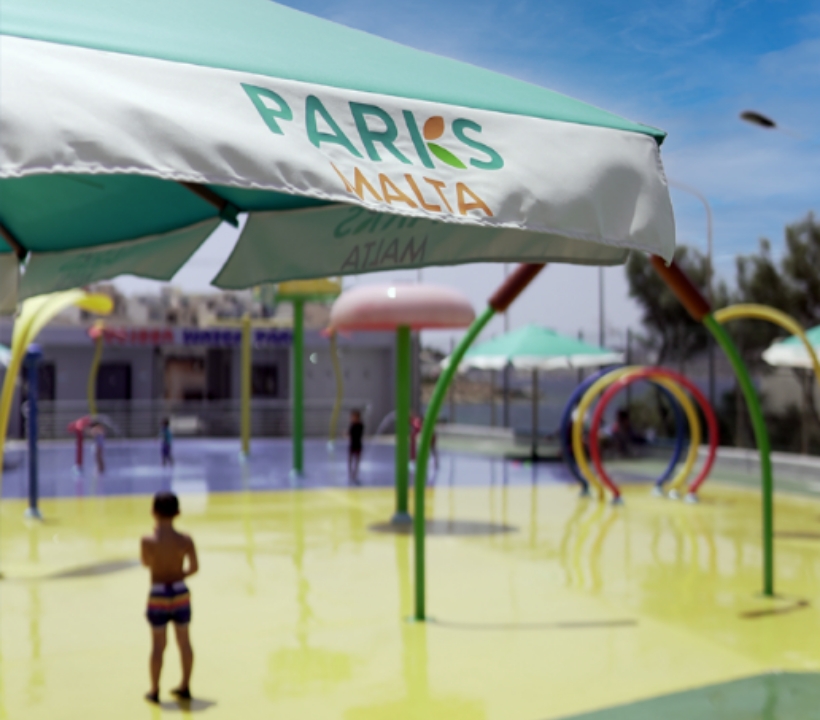Buġibba Water Park
Buġibba, Northwest region of Malta





Amenities
Accessible Amenities
Restroom Facilities
Fountains
Wi-Fi Internet
Playground
Benches
Umbrellas
Restroom Facilities
Bugibba
Water Park FAQs
What is the opening time of water park?
Opening time at the Water Park is from 9.30.00am till 14.30 15:00 till 20.00pm from July to September. Actual dates are announced at the beginning of the summer season. Opening and Closing of parks which are under the responsibility of Parks Malta are always communicated for the benefit of the visitors and tourists on its website and facebook page.
Are foods and drinks allowed in water park?
Only bottled mineral water is allowed inside the park. For the safety and enjoyment of others each visitors are advised to follow Park rules thoroughly which can be viewed once entering the park. In case of queries and clarification our personnel are always ready and happy to be of any assistance to our clients.
Is the water safe at water park?
Yes, water is filtered and sanitised by UV sterilisation and chlorine every morning. So, the water at the park is always safe for our clients. However, this water is not potable water and need not be consumed by anyone using the park.
Do parents require to book beforehand use the facilities of the park?
There is no need for pre-booking to be able to use the Park. Water sessions are open on a first come first serve basis. Each session takes around 20 minutes time.
What is the purpose of Parks Malta - Valley Management Unit’s Research Team?
The Valley Management Unit (VMU) within PARKS is set up to conduct fieldwork and investigate scientifically the valleys of Malta. Their purpose is to digitise valleys and produce valuable data to make it easier for projects and other entities to conduct their work. The VMU has tablets, drones, water quality probes and field cameras amongst other technologies to produce scientific data including geology, hydrology and ecology.
How is the Valley Management Unit involving the public in its work?
We understand the importance of consulting with stakeholders such as NGOs, Local Councils and individuals. In fact, we have just finished a second batch of stakeholder meetings that collected opinions and ideas from people outside of the department so that we can incorporate them in writing of Masterplans for the valleys within our remit. See https://lifeip-rbmp-geoportal-valleymanagement.hub.arcgis.com/pages/masterplans. Further information can be submitted on parksmalta@gov.mt
Where can I find detailed information about the work of the Valley Management Unit?
Information is about the work of the Valley Management can be found on our website and facebook. Furthermore, Parks Malta is currently collaborating on a LIFE IP project that is set to restore and manage valleys in Malta. General information about the project can be found here https://www.rbmplife.org.mt/ and our actions within the project are described fully on our online platform https://lifeip-rbmp-geoportal-valleymanagement.hub.arcgis.com/pages/masterplans which is constantly being updated. You can also find information regarding general Parks Malta works on Facebook https://www.facebook.com/parksmalta.
Why does the Valley Management Unit sometimes remove trees?
Not all trees are good for the environment; certain trees can be alien, meaning that they are not Maltese, and/or invasive which means they are dominating the habitat and taking up the space of other Maltese species.
When this is the case, these trees are sometimes removed and replaced with younger endemic species that are much better for the ecosystem.
Can I access any of the data collected by the Valley Management Unit?
All the data collected by the research team through the LIFE IP project can be found here LIFEIP RBMP Geoportal – Downloads & Contacts (arcgis.com) (open access). This database includes a multitude of information, such as on ecosystem services, ecological and hydrological valley information, as well as land-use in valleys.
Why the valley is full of weeds?
Weeds make part of the natural habitat of valleys. Weeds are important in watercourses to reduce soil erosion, apart from increasing the local biodiversity.
Why some trees look dead?
Some species of native trees are deciduous and drop all their leaves during particular seasons of the year and may look dead.
Why are acacia trees and Castor Oil Plants (Ricinus) being removed?
Acacia trees and Castor Oil Plants are alien invasive species and don’t make part of our natural environment. They are generally controlled and removed as they are very dominant and grow very fast which compete and outgrow our native trees and plant species which grow much slower. By removing alien invasive trees, we enhance the growth of native trees and plants which increase the local biodiversity.
Why are reeds being removed?
The Great Reed (Arundo donax) is highly invasive and does not leave space for other species to grow, thus reduce biodiversity. Reeds may also block the watercourse and cause flooding.
Why we should not litter our valleys?
All valleys are connected to the sea. All litter and plastic that is found in valleys will end up into the sea with rainwater.
